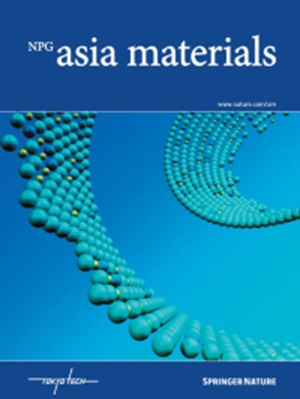Band anisotropy and effective mass renormalization in strained metallic VO2 (101) thin films
IF 8.3
2区 材料科学
Q1 MATERIALS SCIENCE, MULTIDISCIPLINARY
引用次数: 0
Abstract
We explore how strain impacts the band structure of metallic-phase VO2 thin films deposited on TiO2(101) substrates. Employing a combination of X-ray absorption linear dichroism and valence band measurements, we demonstrate that strain can alter the intrinsic band structure anisotropy of metallic VO2. Our findings reveal that reducing the thickness of VO2 films leads to a more isotropic band structure. This observation is further supported by an analysis of the electronic population redistribution in the $${d}_{{||}}{-}{\pi }^{* }$$ bands, which affects the screening length and induces effective mass renormalization. Overall, our results underscore the potential of strain manipulation in tailoring the electronic structure uniformity of thin films, thereby expanding the scope for engineering VO2 functionalities. In this article we studied the evolution of band anisotropy in strained VO2(101) thin films. We found out that strain works as a control agent for the anisotropy and thus controls the features of VO2 bands structure. For this crystal orientation a large strain corresponds to a more homogeneous electronic structure of VO2. This impacts the electrons population redistribution between d|| and π bands, the screening length and the effective mass. By controlling the anisotropy and the band structure properties our results can ease the integration of VO2 into complex electronics.

应变金属 VO2 (101) 薄膜中的带各向异性和有效质量重正化
我们探索了应变如何影响沉积在TiO2(101)衬底上的金属相VO2薄膜的能带结构。采用x射线吸收线性二色性和价带测量相结合的方法,我们证明了应变可以改变金属VO2的本征带结构各向异性。我们的研究结果表明,减小VO2薄膜的厚度会导致更各向同性的能带结构。这一观察结果进一步得到了$${d}_{{||}}{-}{\pi }^{* }$$波段电子居群再分布分析的支持,这影响了筛选长度并诱导了有效的质量重整化。总的来说,我们的研究结果强调了应变操纵在调整薄膜电子结构均匀性方面的潜力,从而扩大了工程VO2功能的范围。本文研究了VO2(101)薄膜应变带各向异性的演化。我们发现应变对各向异性起着控制作用,从而控制了VO2能带的结构特征。对于这种晶体取向,大应变对应于更均匀的VO2电子结构。这影响了d b| |和π带之间的电子居群再分布、屏蔽长度和有效质量。通过控制各向异性和能带结构特性,我们的研究结果可以简化VO2在复杂电子器件中的集成。
本文章由计算机程序翻译,如有差异,请以英文原文为准。
求助全文
约1分钟内获得全文
求助全文
来源期刊

Npg Asia Materials
MATERIALS SCIENCE, MULTIDISCIPLINARY-
CiteScore
15.40
自引率
1.00%
发文量
87
审稿时长
2 months
期刊介绍:
NPG Asia Materials is an open access, international journal that publishes peer-reviewed review and primary research articles in the field of materials sciences. The journal has a global outlook and reach, with a base in the Asia-Pacific region to reflect the significant and growing output of materials research from this area. The target audience for NPG Asia Materials is scientists and researchers involved in materials research, covering a wide range of disciplines including physical and chemical sciences, biotechnology, and nanotechnology. The journal particularly welcomes high-quality articles from rapidly advancing areas that bridge the gap between materials science and engineering, as well as the classical disciplines of physics, chemistry, and biology. NPG Asia Materials is abstracted/indexed in Journal Citation Reports/Science Edition Web of Knowledge, Google Scholar, Chemical Abstract Services, Scopus, Ulrichsweb (ProQuest), and Scirus.
 求助内容:
求助内容: 应助结果提醒方式:
应助结果提醒方式:


